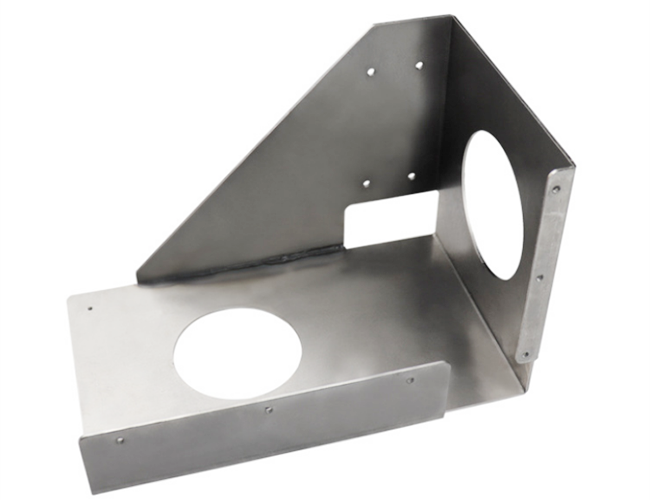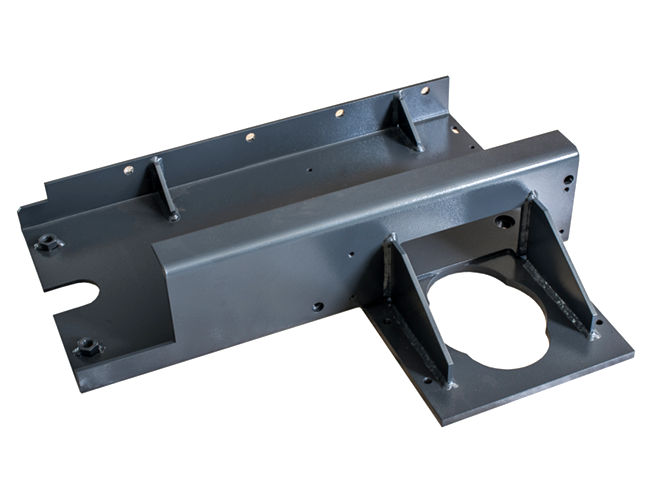


Welding is a manufacturing process and technology of bonding metal or other thermoplastic materials such as plastic in a way of heating, high temperature or high pressure.
Welding is one of the links in the sheet metal processing process. The two separated metal objects are connected together by means of pressure or heating to generate interatomic bonding force. According to the heating degree and process characteristics in the welding process, it can be divided into fusion welding, pressure welding and brazing.
Principle: Fusion welding needs to be locally heated to a molten state at the welding place, that is, welding in a liquid state; pressure welding requires pressure, during which heating can be selected, and it is carried out in a solid state; brazing is the use of brazing in a lower temperature than the material to be welded. The melting point, filling the gap between the joints, is carried out in the form of a combination of solid and liquid.

Technology: Welding techniques include gas welding, hand arc welding, submerged arc welding, electroslag welding and laser welding; pressure welding includes resistance welding, friction welding and diffusion welding; brazing includes soldering iron, flame and furnace brazing.
Requirements for sheet metal parts before welding:
1. The raw materials of all sheet metal parts must meet the requirements of the drawings, otherwise they cannot be cut;
2. It is required that the surface flatness of the welded section steel should not exceed 2/1000, and the total curvature should not exceed 0.3%;
3. Before welding sheet metal parts, all deformed parts must be straightened before welding;
4. Before welding, select the appropriate welding wire, and select different thicknesses and specifications according to parameters such as part size, material thickness and welding requirements.
Specifications and requirements for reverse welding of sheet metal:
1. The welding plate should be flat, without bulging, unevenness and peeling;
2. To ensure that the workpiece is clean. After welding, it must be re-polished with emery cloth to remove the residue of welding slag, welding point and barb corner, and keep the welding seam smooth;
3. The plane welding seam of the box workpiece shall not be higher than the plane. In general, the weld behind the oil should be completely covered;
4. During the welding process, the commutator and welding plane that do not need to be reworked must be strictly protected to avoid arc damage or welding slag damage. As long as the welding is uniform, no random grinding is allowed;
5. After welding, the metal parts to be blued and electroplated should be sandblasted evenly. Strict protection measures should be taken to avoid bumps, scratches and abrasions when flipping.
Process requirements for sheet metal welding:
1. Welders should operate in strict accordance with drawings, process and technical requirements. If the workpiece is not welded correctly due to the reasons on the drawing, it must be re-welded and should be regarded as defective;
2. When welding the groove, it must be processed at the groove. For unwelded workpieces, the weld must be polished or machined;
3. When welding, it should be ensured that the overall dimensions and appearance of the workpiece meet the requirements of the drawings, and there is no IT15 appearance tolerance and no special requirements;
4. If the material needs to be replaced during welding, the written consent of the technical department should be obtained, and the thickness of the steel plate should meet the requirements of the drawings, otherwise it cannot be replaced;
5. The welding size should be strictly in accordance with the drawing requirements. Intermittent welding is not a substitute for continuous welding. There are no clear requirements for the size and length of discontinuous welds, the spacing should be kept uniform, and the spacing is 50mm8~10mm. Continuous welds must be straight, without obvious unevenness, or even without penetration, welding deviation, weld traces, pores and undercuts .
6. The rounded corners should meet the requirements of the drawings, and the thickness of the adjacent parts without rounded corners should be reduced as much as possible.
7. After welding, the weld must be ground to eliminate welding slag and burrs around it;
8. Some parts cannot be welded. Welding of elbows on drawings is not permitted without the written permission of the technical department.
9. When welding sheet metal parts, you can hit the parts to be hammered with a small hammer until the sheet metal parts reach the required size. Do not hit the surface of the board with a heavy hammer or the part will be damaged and discarded.
Welding features: simplifies casting and forging processes; has good sealing; saves metal materials and reduces structural weight; bimetal structure, better integrity.
In sheet metal cabinet processing, not all materials can be welded, and not all materials have good welding properties. Therefore, under the premise of meeting the performance requirements of the equipment, materials with good weldability should be selected.
Scope of application: Due to different principles and characteristics, the scope of application is also different. For example, arc welding is suitable for shipbuilding, boilers, bridges, etc.; friction welding is suitable for dissimilar metals and dissimilar steel products; brazing can be used for welding carbon steel, stainless steel, superalloy, aluminum, copper and other metal materials, and can also connect dissimilar metals, Metals and non-metals, especially for precision, micro and complex multi-brazed weldments.
JAVA Metal introduced advance laser welding machine, and can weld multiple materials.
Main Advantages
Butter apperarance after welding, high efficiency, high quality